Hafnarfjörður 作者: 来源: 发布时间:2021-06-15
一、所属省或是州,具体位置,人口,面积
Hafnarfjörður is a town in the capital area with a population of 29,971 (3rd largest in Iceland) and the town has grown enormously in recent years and decades as other municipalities in the capital area have done. The total land area of the municipality is 143.3 square kilometers (60th largest in Iceland). The harbor that the town is named after was one of the largest trading harbors in the country since the 16th century and a lot of fishing has been done from there in history. In the 18th century, there was talk of making Hafnarfjörður the capital of Iceland, but poor transport conditions there, little reception and little infrastructure became the main reasons why Reykjavík was chosen.
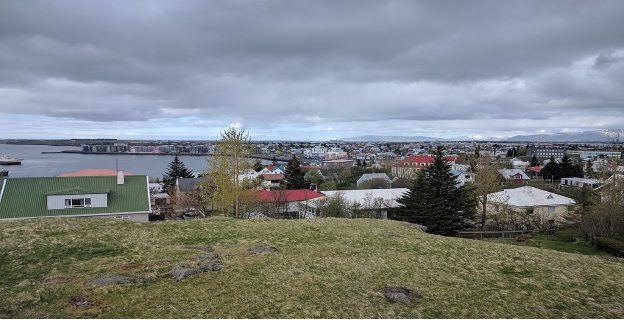
二、自然地理
1.地理条件
The most remarkable physical characteristics of Hafnarfjörður are the wildly shaped lava formations. Enourmous, rough black rocks jut from the earth into craters, crevices and caves the cover the town. Yet here, carefully carved out among these seemingly immobile masses of rock, is a charming and tranquil. Homes peek out from behind boulders, shops sit beside lava flows, and parks are filled with moss-covered crags. In Hafnarfjörður, life exists in concert with the 7,000-year-old rolling lava.
Most people in Hafnarfjörður live on the 18-square kilometer (7-square mile) lava field named Búrfellshraun. This lava originally spewed out of the crater Búrfell, which is located about 7 km (4.3 miles) east of Hafnarfjörður and is part of the Krýsuvík volcano. From the Búrfell eruption, lava flowed into two main streams transforming into remarkable formations when it passed by and around a lake. Some of these lava fromations are now sites designated for preservation. At the Litluborgir site, beside Helgafell Mountain, the lava formed into pseudocraters and other unusual gnarled shapes. At Kaldárhraun and Gjárnar sites sharply upheaved lava rests amonge a large expanse of undisturbed, ropy pahoehoe lava.
The town is planned and built around nature. It sits in the middle of a lava field, and in many places the lava formations have remained untouched, giving the town a very organic feel to it. This is what gives Hafnarfjörður the nickname "the town in the lava," and it is also partly because of this that the town has become associated with legends of the Icelandic elves.
http://www.visithafnarfjordur.is/history-and-nature/living-on-the-lava-field/
2. 交通情况
Hafnarfjörður is conveniently located just a stone's throw from Reykjavík, and within easy reach of Keflavík international airport. Bus nr. 1 runs to Hafnarfjordur from the centre of Reykjavik and it takes only about 20 minutes.
Keflavík international airport is 39 km from Hafnarfjörður. Hafnarfjörður can be reached from Keflavík Airport by following road 41. In order to get from other parts of the country to Hafnarfjörður, drive Road 1 to Reykjavík. Road 1 connects to all regions of the country, except the interior and the Westfjords. Once in Reykjavík turn into road 49 and turn left into into road 41.
http://www.visithafnarfjordur.is/accommodation-and-transport/bus/
三、经济发展和规模
At the end of 2019, 2,408 employees worked for the municipality in 1,509 full-time equivalent positions. In comparison, the municipality had 2,037 employees in 1,475 full-time equivalent positions at the end of 2018.
The salaries of the town council and the mayor amounted to ISK 89.8 million in 2019. In comparison, the salaries of the town council and the mayor amounted to ISK 106.3 million in 2018.
A total of ISK 4.8 billion in new loans were taken out in 2019. Installments totaling ISK 4.1 billion were paid.
The municipality's financial position remained stable during the year and the debt benchmark, which was 112% at the end of 2018, was unchanged at the end of 2019 or below the debt benchmark according to the Regulation on Financial Standards and Supervision of Municipal Finances no. 502/2012, according to which the ratio may not exceed 150%. When calculating the debt benchmark, claims are deducted in advance in the amount of ISK 1.9 billion due to the Contingency Fund and the Pension Supplement Fund in connection with the settlement of Division A of Brú, cf. temporary provisions of Regulation no. 1212/2015 on accounting, budgets and annual accounts of municipalities.
https://www.hafnarfjordur.is/stjornsysla/baerinn-i-tolum/arsreikningar/
四、产业特点/重点项目
Hafnarfjörður is one of the oldest communities in Iceland. merchandts have been peddling their wares and fishermen landing their catches here continuously since the 14th century.
It is the natural harbour after hcih the town is named (Hafnarfjörður means Harbour Fjord) that is the main reason for the community's prosperity. Iceland's history is closely tied to the sea, and so is that of Hafnarfjörður. The sea provides with its commerical and cultural lifeline.
The town was established by foreign merchants who found the secluded harbour convenietly located near the royal estate at Bessastaðir (now the residence of the president of Iceland).
Englishmen began trading in Hafnarfjörður in the 15th century, although Dutch and German merchants also traded with Icelanders. Over the centuries, various European nations competed for trade supremacy in the community, and by the 18th century, Hafnarfjörður had become Iceland's major trading centre. In the late 19th century, when decked boats rather than rowing boats were used for fishing, the population surged again, and Hafnarfjörður was incorperated as a town in 1908.
Fishing, commerce and services have long been the prominent business sectors in Hafnarfjörður. Traditionally, several fishing vessels of all sizes have been based in the town and life more less revolved around fishing. This meant that fathers were often months at sea and it was not unusual for children in town to carry their mother's name as a surname. Nowadays, tourism and aluminium production are equally importatn to the local economy.
Just two kilometres (1.2 miles) outside of Hafnarfjörður is an aluminium smelter, run by Alcan. The smelter was originally built in 1969, and it has improved its cleaning process since then, especially regarding fluoride. Local elections were held in May 2006, where the people of the town voted against extension of the smelter.
An excerpt from a 2018 news article gives information on Hafnarfjörður’s debt and budget: Adda María Jóhannsdóttir, leader of the Samfylking in the town council, says it is worrying that debt is increasing at the town at the same time as there are indications of a cooling in the economy. "The increase in debt certainly has certain explanations, but it is interesting to note that the debt ratio is rising despite the fact that tax revenue has increased. Let us also remember that last year's budget was a clear indication that it was an election budget. Much was promised as enormous investments were made that will bind the municipality's hands for many years. Revenue from the sale of plots had been assumed against the projects that were planned, but it has not gone as planned and the sale of plots is about ISK 1.5 billion below what was originally planned.
http://www.visithafnarfjordur.is/map-and-general-info/the-town-of-hafnarfjordur/
https://baerinnokkar.is/2019/05/05/skuldahlutfall-hafnarfjardar-haekkar-i-fyrsta-sinn-fra-hruni/
五、风景名胜,景点( attractions)
1. Hafnarfjörður´s Harbour
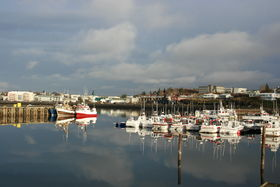
Hafnarfjörður´s growth and prosperity has been closely linked to fishing over the years. Fisk stocks migrated along the Faxaflóa Bay for centuries. Sometimes going far into the fjord, near the Fiskiklettur are, where they could even be caught from dry land. In those days the place was really booming, with people in every shack and shanty. When deck vessels began fishing, results were more impressive and around 1870 the importance of Hafnarfjörður´s harbour became even more obvious. Greater numbers of foreign fishing vessels sought safe harbour here. At the start of the 20th century, line fishing, motorised vessels and trawlers became prominent in Iceland, with many Icelandic and foreign vessels being based in Hafnarfjörður. Among the foreign vessels, most were British or Norwegian, but these phased out by 1929. Icelandic trawler fishing began in 1905 with the purchase of the Coot from abroad, and its base was here in town. Within a few years, more trawlers were based in town, with fish processing companies being established as well. After World War II more trawlers and several large motor boats joined the town fleet, with the first stern trawler arriving in 1973.
In earlier days it was usual for ships to anchor offshore and have their cargo shuttled to shore in smaller boats. Merchants and fishermen each had their own piers in front of their warehouses, though ships could not dock at shore. More mechanization called for improved facilities to serve the rapidly growing fleet and the nation´s first deep-water pier was completed in Hafnarfjörður on 1913. Since then, the harbour has constantly evolved with newer facilities replacing the old. So much has the harbour changed that Bjarni Sívertsen, the Knight, might have hard time recognizing his home port now. Landfill has been added to extend the shore outward and give more docking space and expansion along these lines continues to this day.
http://www.visithafnarfjordur.is/map-and-general-info/the-town-of-hafnarfjordur/
2. Straumur - Lava ponds and hiking
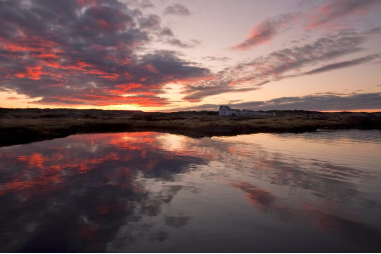
In the westernmost region of Hafnarfjörður, lava ponds and ancient ruins dot the shoreline, offering a memorable walk that provides insight into an historical area. In the early 1400s Straumsvík was a thriving commercial region. Here, British, Danish, and German merchants battled, each seeking control of goods and the land. Today amidst the lava lagoons and beside the crashing surf, the crumbling ruins bring to life a story of long ago.
Many walkers begin their stroll beside the big white farmhouse. Designed by the former national architect Guðjón Samúelsson, this classic, peaked-roof style farm is a charming landmark. Follow the gravel road or amble along the seaside path to spot the remnants of a deserted village. With a careful eye and a slow gait, it's possible to find old stonewalls, collapsing farms, age-old cairns, fishing tools, or fragments of kitchens, wells, barns, and what was once a cattle pen.
After a few minutes on either path, you'll soon have turned away from the noisy road and the large aluminium plant. From this quiet trail, you can listen as the birds dive into the waves or watch as the sunset glows pink over the Atlantic. Because there is usually less snow along the coastline, this is a lovely walk year-round.
http://www.visithafnarfjordur.is/history-and-nature/straumur/
3. Hafnarfjörður Museum
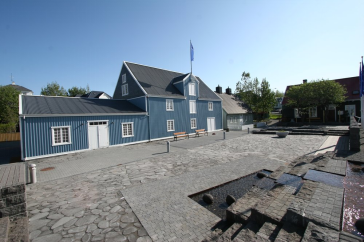
Hafnarfjörður Museum is a museum of cultural artefacts and photographs of Hafnarfjörður town. Its objective is to collect, document, preserve, protect and study objects and artefacts of the region's cultural history and present them to the public. The cultural area represented in Hafnarfjörður Museum is the town of Hafnarfjörður and the surrounding region.
http://museum.hafnarfjordur.is/en/
六、历史文化
1.历史
Hafnarfjörður takes its name (meaning harbour fjord) from the area's excellent natural harbour. The town is first named in the medieval Landnámabók, and the earliest reports of voyages to Hafnarfjörður date from the end of the 14th century. Englishmen began trading in Hafnarfjörður in the 15th century, but German merchants followed in their wake and eventually drove the English out. The first Lutheran church in Iceland was raised at Háigrandi, opposite Óseyri, just outside the small boat harbour in 1533. After that, the Hanseatic traders prevailed in town until 1602, based at Hvaleyri. At this point, the Danish monarchy established a Danish trade monopoly in Iceland which lasted until late in the 18th century. During this period, Hafnarfjörður was the nation's busiest trade centre.
In 1793, Bjarni Sívertsen settled here and became influential in local business and international trade, setting up a major commercial fishing operation. His enterprise and initiative signalled the start of impressive commerce in the town. Ever since, he has been called "the father of Hafnarfjörður" and nicknamed "Sir Bjarni". Around 1870, dramatic changes took place in Icelandic fishing. Residents followed the growing trend in Iceland of using decked boats rather than row-boats. This led to even more employment and rapid growth, and Hafnarfjörður attained official municipal status in 1908. The first mayor was Páll Einarsson, who later became the mayor of Reykjavík. The first road between Reykjavík and Hafnarfjörður was finished in 1898. The first hydrological power plant in Iceland was built in Hafnarfjörður in 1904.
The Coot, Iceland's first trawler, operated from Hafnarfjörður between 1905 and 1908.[2] Its boiler stands by the roundabout on the junction of Reykjavíkurvegur, Strandgata and Vesturgata. A harbour for large commercial ships was raised in 1912, and the first car arrived in 1913.
After World War II, more advanced trawlers and numerous motorised ships were added to the fleet. The town's first stern trawler appeared in 1973. Today, Hafnarfjörður is one of the nation's largest fishing centres and the site of Iceland's first fish wholesalers' auction market. Through the years, Hafnarfjörður's dynamic local economy has been strongly linked to fishing, although freight transport has recently become the major harbour activity. And now, the town is Iceland's second-ranked import and export harbour.
2. 文化体育
Hafnarfjörður is in many ways unique, especially for the vibrant town centre, charming dock area and easy access to diverse and beautiful natural treasures. Some of them are within walking distance from the town centre: Hellisgerði, Víðistaðatún, Lækurinn and Hamarinn, to name a few. Many residents in Hafnarfjörður have the luxury of having Helgafell, Hvaleyrarvatn, Ásfjall and Ástjörn in their backyard and other residents have these treasures just outside the town limits. In the upper areas of Hafnarfjörður there are adventures at every turn.
Hafnarfjörður, is a friendly town, surrounded by lava and natural treasures, that has grown considerably the last decade and has in a unique way managed to maintain a cosy atmosphere along with being active in welcoming everyone that visits the town.
in the 1920s, Hafnarfjörður became the cradle of handball. To this day, the town remains a bastion of this hugely popular sport in Iceland.
The town is the site of an annual Viking festival, where Viking culture enthusiasts from around the world display reconstructions of Viking garb, handicraft, sword-fighting and longbow shooting. It takes place in June each summer.
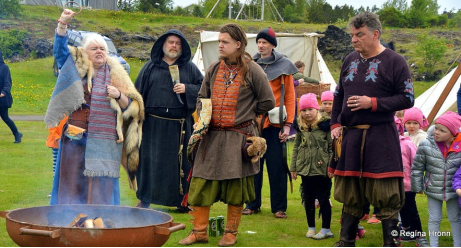
http://www.visithafnarfjordur.is/map-and-general-info/did-you-know/
七、其他信息
Hafnarfjörður is in many ways dominated by its neighbour Reykjavík. However, it is also a separate town with its own centre and independent town spirit. It forms a sort of second centre of gravity in the greater Reykjavík area (or the greater Hafnarfjörður area as some locals call it), with most of the suburbs having formed between these two towns. The name of the town means harbour-fjord and Hafnarfjörður has a large harbour, used both for imports, exports and fishing. It also has some of the most important industrial areas around the capital.
https://en.wikivoyage.org/wiki/Hafnarfj%C3%B6r%C3%B0ur#Q103725
八、联系方式
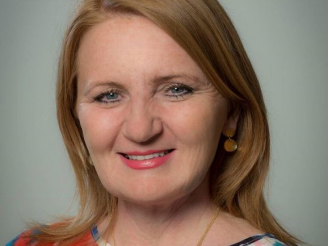
Mayor: Rósa Guðbjartsdóttir
Telephone: 585 5500
Email: rosa@hafnarfjordur.is
https://www.hafnarfjordur.is/
